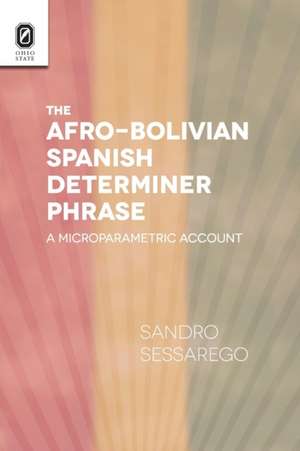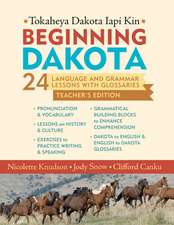The Afro-Bolivian Spanish Determiner Phrase: A Microparametric Account: Theoretical Developments in Hispanic Lin
Autor Sandro Sessaregoen Limba Engleză Paperback – 31 mai 2016
In this important new study, Sandro Sessarego provides a syntactic description of the Afro-Bolivian Spanish determiner phrase. Afro-Bolivian Spanish is one of the many Afro-Hispanic dialects spoken across Latin America and, from a theoretical point of view, is rich in constructions that would be considered ungrammatical in standard Spanish. Yet these constructions form the core grammar of these less-prestigious, but equally efficient, syntactic systems. Because of the wide variety of their usages, Sessarego’s study of these contact varieties is particularly valuable in developing and refining theories of syntactic microvariation.
This dialect presents phenomena that offer a real challenge to current linguistic theory. The Afro-Bolivian Spanish Determiner Phrase elaborates on the importance of enhancing a stronger dialogue between formal generative theory and sociolinguistic methodology, in line with recent work in the field of minimalist syntax. Sessarego’s study combines sociolinguistic techniques of data collection with generative models of data analysis to obtain more fine-grained, empirically testable generalizations.
This dialect presents phenomena that offer a real challenge to current linguistic theory. The Afro-Bolivian Spanish Determiner Phrase elaborates on the importance of enhancing a stronger dialogue between formal generative theory and sociolinguistic methodology, in line with recent work in the field of minimalist syntax. Sessarego’s study combines sociolinguistic techniques of data collection with generative models of data analysis to obtain more fine-grained, empirically testable generalizations.
Preț: 250.64 lei
Nou
Puncte Express: 376
Preț estimativ în valută:
47.96€ • 50.08$ • 39.60£
47.96€ • 50.08$ • 39.60£
Carte tipărită la comandă
Livrare economică 11-17 aprilie
Preluare comenzi: 021 569.72.76
Specificații
ISBN-13: 9780814253045
ISBN-10: 0814253040
Pagini: 182
Dimensiuni: 152 x 229 x 15 mm
Greutate: 0.27 kg
Ediția:1
Editura: Ohio State University Press
Colecția Ohio State University Press
Seria Theoretical Developments in Hispanic Lin
ISBN-10: 0814253040
Pagini: 182
Dimensiuni: 152 x 229 x 15 mm
Greutate: 0.27 kg
Ediția:1
Editura: Ohio State University Press
Colecția Ohio State University Press
Seria Theoretical Developments in Hispanic Lin
Recenzii
“Theoretically grounded on microparametric syntax, this well-focused investigation offers fresh and fascinating insights into a speech variety—Black Highland Bolivian Spanish—that has been overlooked until recently. As such, Sessarego’s valuable study adds further momentum to the ever more nuanced study of Black speech in Latin America, and provides definitive proof that the tapestry of New World Spanish is often unusually rich in remote and difficult-to-access areas.” —Armin Schwegler, professor of Spanish linguistics, University of California, Irvine
“The combination of syntactic theory and sociolinguistic variationist approaches is innovative and makes a significant contribution to broader areas of linguistic research, in particular the principled study of linguistic variation and the application of theoretical models to issues of historical dialectology. Sessarego has made a very cohesive case that is consistent with both known historical data and observable linguistic behavior.” —John Lipski, Edward Erle Sparks Professor of Spanish and Linguistics, Pennsylvania State University
Notă biografică
Sandro Sessarego is an assistant professor of Hispanic linguistics in the Department of Spanish and Portuguese at the University of Texas at Austin.
Cuprins
Chapter 1 • Introduction
1.1. General Introduction and Objectives of This study
1.2. Theoretical Framework
1.3. Organization of the Volume
Chapter 2 • A Sociohistorical and Linguistic Sketch of Afro-Bolivian Spanish
2.0. Introduction
2.1. Terminological Clarifications
2.2. Processability Theory and the Interlanguage Hypothesis
2.3. Vernacular Universals
2.4. Afro-Bolivian Spanish Traditional Features
2.5. On the Scarcity of Spanish Creoles in Latin America
2.6. Black Slavery in Bolivia
2.6.1. First Phase: From the Sixteenth to the Mid-Seventeenth Century
2.6.2. Second Phase: From the Mid-Seventeenth to the Mid-Twentieth Century
2.7. Black Slavery in Mizque
2.8. Black Slavery in Los Yungas
2.9. Conclusion
Chapter 3 • Language Variation and the Minimalist Program
3.0. Introduction
3.1. Accounting for Variation
3.2. Approaches to the Study of Language Variation
3.2.1. The Formal Approach
3.2.2. The Sociolinguistic Approach
3.2.3. The Diachronic Approach
3.2.4. The Microparametric Approach
2.3.5. Variability in the Minimalist Program
3.3. Variability Across Closely Related Dialects: The Afro-Hispanic Case
3.4. Data Collection and Methodology
3.5. Conclusion
Chapter 4 • From NP to DP
4.0. Introduction
4.1. The Determiner Phrase Hypothesis
4.1.1. Abney (1987)
4.1.2 Szabolcsi (1983, 1987, 1989, 1994)
4.2. In between N and D
4.2.1. Ritter (1991, 1993)
4.2.2. Picallo (1991)
4.2.3. Cinque (1990, 1993)
4.2.4. Valois (1991)
4.2.5. Carstens (2000)
4.3. The Status of NPs and DPs
4.3.1. Longobardi (1994)
4.3.2. Chierchia (1998)
Chapter 5 • Semantic and Syntactic Properties of “Bare” Nouns
5.0. Introduction
5.1. ABS Nouns and Chierchia’s Nominal Mapping Parameter
5.2. Number and Mass Interpretation
5.3. Bare Nouns as Names of Kinds
5.4. The Semantics of (In)definiteness
5.4.1. Bare Nouns and Indefiniteness
5.4.2. Bare Nouns and Definiteness
5.5. Bare Nouns in ABS: A Unified Account
5.6. Conclusion
Chapter 6 • N-Ellipsis
6.0. Introduction
6.1. Data
6.2. Preposition Uses in ABS and stSp
6.3. Previous Analyses
6.3.1. Brucart & Gràcia (1986)
6.3.2. Brucart (1987)
6.3.3. Kester & Sleeman (2002)
6.3.4. Ticio (2003, 2005)
6.4. Toward a New Proposal
6.5. Conclusion
Chapter 7 • Gender and Number Agreement
7.0. Introduction
7.1. Data
7.2. Agree and Agreement
7.3. Applying the Theory to the Data
7.4. Conclusion
Chapter 8 • Variation in the Determiner Phrase
8.0. Introduction
8.1. Methodology
8.2. Qualitative Data
8.3. Quantitative Data
8.4. A Formal Analysis
8.5. The Local Agreement Gradience Function
8.6. Conclusion
Chapter 9 • Conclusion
1.1. General Introduction and Objectives of This study
1.2. Theoretical Framework
1.3. Organization of the Volume
Chapter 2 • A Sociohistorical and Linguistic Sketch of Afro-Bolivian Spanish
2.0. Introduction
2.1. Terminological Clarifications
2.2. Processability Theory and the Interlanguage Hypothesis
2.3. Vernacular Universals
2.4. Afro-Bolivian Spanish Traditional Features
2.5. On the Scarcity of Spanish Creoles in Latin America
2.6. Black Slavery in Bolivia
2.6.1. First Phase: From the Sixteenth to the Mid-Seventeenth Century
2.6.2. Second Phase: From the Mid-Seventeenth to the Mid-Twentieth Century
2.7. Black Slavery in Mizque
2.8. Black Slavery in Los Yungas
2.9. Conclusion
Chapter 3 • Language Variation and the Minimalist Program
3.0. Introduction
3.1. Accounting for Variation
3.2. Approaches to the Study of Language Variation
3.2.1. The Formal Approach
3.2.2. The Sociolinguistic Approach
3.2.3. The Diachronic Approach
3.2.4. The Microparametric Approach
2.3.5. Variability in the Minimalist Program
3.3. Variability Across Closely Related Dialects: The Afro-Hispanic Case
3.4. Data Collection and Methodology
3.5. Conclusion
Chapter 4 • From NP to DP
4.0. Introduction
4.1. The Determiner Phrase Hypothesis
4.1.1. Abney (1987)
4.1.2 Szabolcsi (1983, 1987, 1989, 1994)
4.2. In between N and D
4.2.1. Ritter (1991, 1993)
4.2.2. Picallo (1991)
4.2.3. Cinque (1990, 1993)
4.2.4. Valois (1991)
4.2.5. Carstens (2000)
4.3. The Status of NPs and DPs
4.3.1. Longobardi (1994)
4.3.2. Chierchia (1998)
Chapter 5 • Semantic and Syntactic Properties of “Bare” Nouns
5.0. Introduction
5.1. ABS Nouns and Chierchia’s Nominal Mapping Parameter
5.2. Number and Mass Interpretation
5.3. Bare Nouns as Names of Kinds
5.4. The Semantics of (In)definiteness
5.4.1. Bare Nouns and Indefiniteness
5.4.2. Bare Nouns and Definiteness
5.5. Bare Nouns in ABS: A Unified Account
5.6. Conclusion
Chapter 6 • N-Ellipsis
6.0. Introduction
6.1. Data
6.2. Preposition Uses in ABS and stSp
6.3. Previous Analyses
6.3.1. Brucart & Gràcia (1986)
6.3.2. Brucart (1987)
6.3.3. Kester & Sleeman (2002)
6.3.4. Ticio (2003, 2005)
6.4. Toward a New Proposal
6.5. Conclusion
Chapter 7 • Gender and Number Agreement
7.0. Introduction
7.1. Data
7.2. Agree and Agreement
7.3. Applying the Theory to the Data
7.4. Conclusion
Chapter 8 • Variation in the Determiner Phrase
8.0. Introduction
8.1. Methodology
8.2. Qualitative Data
8.3. Quantitative Data
8.4. A Formal Analysis
8.5. The Local Agreement Gradience Function
8.6. Conclusion
Chapter 9 • Conclusion
Descriere
Develops a syntactic description of the Afro-Bolivian Spanish determiner phrase.






